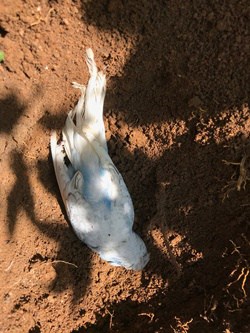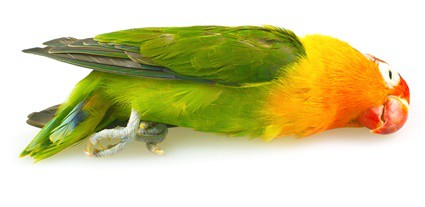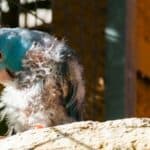Last Updated on January 28, 2024 by Carrie Stephens
When a pet parrot dies, you must decide what to do with the corpse within 1 to 2 days.
The options are burial and cremation. You can bury the parrot’s body in the yard if it’s legal where you live. You can pay for a plot at a local pet cemetery if it’s illegal.
You could have the parrot cremated. Private cremation is more expensive, but you get to keep the ashes.
Many owners bury their parrots in the yard. While most states allow pets to be buried on private property, some prohibit it. For example, pet burial is legal in Alaska but illegal in Arkansas.
My Parrot Died: What To Do
You’ll feel distraught when you discover your beloved pet parrot has died.
You don’t have to decide what to do straight away. However, as decomposition sets in quickly, you must wrap the body in a towel or blanket and put it in a tightly tied plastic bag.
There are 3 preferred options when it comes to dealing with a deceased parrot’s corpse:
- Bury the parrot in your yard (local laws permitting).
- Purchase a burial plot at a pet cemetery.
- Get the parrot cremated.
You can contact animal control for advice. Some cities offer deceased animal removal services. For example, the City of Albuquerque will pick up and dispose of a pet’s body for free.
It’s legal to dispose of the parrot’s body with household trash if you wish to. However, most owners dislike this idea, as it’s perceived as disrespectful to the bird’s memory.
Consider whether you want a necropsy performed on the parrot to determine the cause of death.

Bird Necropsy Cost
An avian necropsy can cost up to $500, but the price depends on the parrot’s size and which tests are required. Some vets perform them for free or at a lower-than-average price.
An avian necropsy (post-mortem) involves the following:
- Inspecting the body to check for obvious causes of death like injury.
- Examining internal organs for malformations, defects, or signs of disease.
- Running tests for viruses or bacteria if no cause of death is found.
According to Veterinary Clinics of North America, companion birds can carry infectious diseases. If you own other birds, get a necropsy done in case they have the same condition.
Necropsies should be carried out within 24 hours of the parrot’s death. You can place the parrot’s body in the refrigerator in a sterile, airtight plastic bag until it’s time for the examination.
Burying A Dead Parrot
When a pet parrot dies, you may want to bury it in your yard.
It doesn’t cost anything and is a dignified and respectful way to say goodbye to a beloved companion. You can visit the parrot’s grave whenever you like.
Before you bury the parrot, check that it’s legal where you live.
There are no federal laws on burying pets in your yard because each state has specific regulations. In some cases, these rules vary between cities and counties.
| State | Can You Bury A Pet Bird on Your Property? |
| Alabama | Yes, a minimum of 2 feet underground. |
| Alaska | Yes |
| Arizona | There are no state-wide laws, so check with your city. |
| Arkansas | No |
| California | No |
| Colorado | Yes, if the parrot wasn’t carrying an infectious disease. |
| Connecticut | Yes, as long as the grave is sufficiently deep to avoid being unearthed by wildlife. |
| Delaware | Yes, but not near a water source. |
| Florida | Yes, as long as the grave is sufficiently deep to avoid being unearthed by wildlife. |
| Georgia | Yes, as long as the grave is sufficiently deep to avoid being unearthed by wildlife. |
| Hawaii | Yes |
| Idaho | Yes, a minimum of 3 feet underground. |
| Illinois | Yes, if the bird is not carrying an infectious disease. |
| Indiana | Yes, a minimum of 4 feet underground. |
| Iowa | Yes |
| Kansas | Yes, provided the burial does not endanger the ecosystem. |
| Kentucky | Yes, at least 6 feet underground, the bird mustn’t have been carrying an infectious disease. |
| Louisiana | Yes, at least 6 feet underground. The bird also mustn’t have been carrying an infectious disease. |
| Maine | Yes, if the bird isn’t carrying an infectious disease and isn’t buried near a water source. |
| Maryland | Yes, a minimum of 4 feet underground. |
| Massachusetts | There are no state-wide laws, so check with your city. |
| Michigan | Yes, if the burial is not near a water source. |
| Minnesota | Yes, if the grave isn’t near a water source and is deep enough to avoid being unearthed by wildlife. |
| Mississippi | Yes, a minimum of 2 feet underground. |
| Missouri | Yes, at least 3 feet underground and not near a water source. |
| Montana | Yes, a minimum of 2 feet underground. |
| Nebraska | Yes, a minimum of 5 feet underground and 500 feet away from a water source. |
| Nevada | Yes, a minimum of 3 feet underground. |
| New Hampshire | Yes, a minimum of 75 feet from a water source. |
| New Jersey | Yes, a minimum of 2 feet underground. |
| New Mexico | Yes |
| New York | There are no state-wide laws, so check with your city. |
| North Carolina | Yes, at least 3 feet underground and not near a water source. |
| North Dakota | Yes, a minimum of 3 feet underground; the parrot can’t have been carrying an infectious disease. |
| Ohio | Yes, but specific regulations vary from city to city. |
| Oklahoma | Yes, a minimum of 3 feet underground. |
| Oregon | Yes, a minimum of 3 feet underground. |
| Pennsylvania | Yes, burial must occur within 48 hours of the parrot’s death. |
| Rhode Island | There are no state-wide laws, so check with your city. |
| South Carolina | Yes, a minimum of 1 foot underground. |
| South Dakota | Yes, a minimum of 3 feet underground and within 36 hours of the animal’s death. |
| Tennessee | Yes, a minimum of 3 feet underground and not near a water source. |
| Texas | Yes, a minimum of 3 feet underground. |
| Utah | Yes, burial must occur within 48 hours of the parrot’s death. |
| Vermont | There are no state-wide laws, so check with your city. |
| Virginia | Yes, burial must occur within 48 hours of the parrot’s death. |
| Washington | There are no state-wide laws, so check with your city. |
| West Virginia | Yes, a minimum of 3 feet underground. |
| Wisconsin | There are no state-wide laws, so check with your city. |
| Wyoming | Yes, but some counties require you to seek approval beforehand. |
Before burying a parrot, always check with the town board or city council. In some areas, local ordinances restrict how and where dead animals can be buried.
You can only bury a parrot on your property, not public or government-owned land. According to Bay News 9, a Floridian woman was forced to remove her dog’s body after she buried it in a public park.
You’ll need permission from the landlord for rental properties. Also, if the neighborhood has a Homeowner’s Association, you must seek their approval first.
How To Bury A Parrot
Conduct the parrot’s burial as soon as possible. Ideally, keep the deceased parrot double-bagged in a refrigerator or freezer until it’s time to bury it, especially if you’re waiting longer than a day.
Burial Plot
You can only bury the parrot on your property or private property with the landowner’s permission. Most pet owners choose their backyard.
The state may have laws on where you can bury a dead animal. For example, you can’t bury a parrot near a water source in several states. If there are wells, ensure the burial site is far enough away.
Dig The Grave
Use a shovel or spade to dig a hole wide enough to contain the parrot. Most states have regulations defining how deep the parrot’s grave should be.
Most states, like Idaho, Oregon, and Texas, require the animal to be buried at least 3 feet underground. In Maryland, the grave must be a minimum of 4 feet deep; in Louisiana, it’s 6 feet.
Appropriate Casket
You don’t have to bury the parrot in a casket because you can put the body directly in a grave.
If you want to use a casket, choose one made from a natural, biodegradable material. Don’t use a plastic box, as this won’t decompose. You can use a wooden or cardboard box, such as a shoebox.
Another alternative is to place the parrot’s corpse inside a bag. Again, the bag must be made of a biodegradable material. Suitable materials include the following:
- Cotton.
- Hemp.
- Jute.
- Bamboo.
- Linen (made from flax).
- Rayon (made from natural cellulose fibers).
Don’t use a plastic or man-made fabric bag like polyester. Applied Microbiology and Biotechnology stated that most plastics (like polyethylene) aren’t biodegradable.
Bury The Bird Safely
Place the parrot’s body in the hole and cover it with the soil you dug up. Ideally, wear gloves when doing so. If you wish, you can say some words in memoriam.
Pack the soil down firmly so it’s hard for scavengers to dig up. You can cover the top of the grave with stones or slabs for added protection.
In addition, you can mark the spot with a grave marker, like a headstone or wooden cross.

Bury A Parrot At A Pet Cemetery
Pet cemeteries are licensed, registered graveyards that exclusively house non-human animals. Although they’re usually associated with dogs and cats, they’re okay for pet birds.
If you want to lay a parrot to rest at a pet cemetery, you’ll have to pay for the following:
- Casket (usually a requirement).
- Burial plot.
- Fee for digging the grave.
This may cost between $500 and $4,000. You’ll also have to pay extra if you want a headstone or a memorial service for the parrot.
Some pet cemeteries offer a grave maintenance service for a fee.
Cremating Parrots
Some pet cemeteries have crematoriums on-site. Organizations like the Animal Humane Society also offer pet cremation services.
There are 3 main types of cremation available for parrots:
| Private cremation: | This costs around $85, depending on the size of the bird. The parrot will be cremated privately, and you can keep its cremains (ashes). |
| Communal cremation: | This is the more affordable option, costing around $35. The parrot will be cremated together with other people’s pets. However, you won’t be able to keep the ashes. |
| Witnessed cremation: | You visit the crematorium and see the parrot being cremated. This usually costs an extra $30 on top of the fee for the private cremation. |
A vet may recommend a cremation service that’ll suit your requirements. Smaller practices may even offer to organize everything and send the parrot’s body away for you.
Once the parrot is cremated, scatter the remains or keep them in an urn or decorative box. You could even have jewelry or a glass ornament for the parrot’s ashes.
Seek permission from the landowner before scattering the parrot’s ashes on private property. Check with the city first before scattering the ashes on public land.





